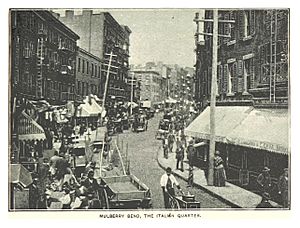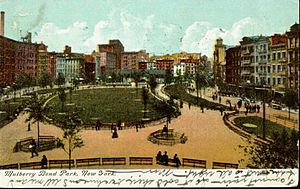Mulberry Bend facts for kids
Mulberry Bend was a famous area around a curve on Mulberry Street. It was part of the Five Points neighborhood in Lower Manhattan, New York City. Today, this area is located in what is now Chinatown in Manhattan.
Contents
Where Was Mulberry Bend?
Mulberry Bend was bordered by several streets. To the north was Bayard Street. To the south was Cross Street, which was later renamed Park Street in 1854. Orange Street, renamed Baxter Street in 1854, was to the west. Mulberry Street formed the eastern border.
The "Bend" in the street happened because of the natural shape of the land. Orange and Mulberry Streets first went from southeast to northwest. Then, they turned north at the "Bend." This turn helped them avoid the Collect Pond and the low, wet land around it to the west. Today, a park called Columbus Park is located exactly where the Bend used to be.
Life in Mulberry Bend
Mulberry Bend was known as one of the toughest parts of the Five Points area. It had many small, hidden alleyways with names like Bandit's Roost, Bottle Alley, and Ragpickers Row.
In 1897, thanks to the efforts of a Danish photojournalist named Jacob Riis, Mulberry Bend was torn down. Riis showed people how bad the living conditions were there. After the buildings were removed, the area was turned into Mulberry Bend Park. This new urban green space was designed by Calvert Vaux. In 1911, the park was renamed Columbus Park.
A few old apartment buildings, called tenements, from before the park was built are still standing on the east side of Mulberry Street. For example, 48-50 Mulberry Street was even mentioned in Jacob Riis's famous book, How the Other Half Lives.
Cross Street was renamed "Mosco Street" in 1982. This was done to honor Frank Mosco, a community activist from the Lower East Side. The part of Cross Street between Mulberry and Baxter Streets was closed off and added to Columbus Park. A small triangular area between Cross and Worth Streets was also added. Worth Street, which was created in 1859, is now the southern edge of Columbus Park.
Jacob Riis wrote about Mulberry Bend in his book How The Other Half Lives:
Where Mulberry Street bends like an elbow near the old Five Points area, you find "the Bend." This was the terrible heart of New York's slums. Long ago, cows used to walk a path here. Now, you might hear sounds, but they remind you of rag-pickers' carts, not green fields. For as long as people could remember, this old path was a huge, crowded place for people. There is only one "Bend" in the world, and that is enough. The city leaders, after many years of people asking for changes, decided it was too much and had to be torn down. A new park would take its place. It would bring sunlight and fresh air, just like what happened at the Five Points. Change was desperately needed. Many of the worst apartment buildings were found around "the Bend." Even with constant police visits, the crowds living there could not be controlled. In the many back alleys and hidden paths, people shared small, broken-down shelters. These places were filled with trash from the city's dumps. This was also a place where people who didn't work often lived. "The Bend" was home to both tramps and rag-pickers.
Places in Mulberry Bend
Baxter Street Dudes
- 21 Baxter Street: The Baxter Street Dudes were a group of teenage boys in New York. Many of them used to sell newspapers or shine shoes. In the 1870s, they created a small theater in the basement of a bar at 21 Baxter Street. They used stolen and found items for their stage, costumes, and props. They called their theater the Grand Duke's Theatre. Here, they wrote and performed plays, musicals, and variety shows. Other street toughs and visitors to the slums enjoyed their shows. Eventually, the city closed them down because they didn't pay an "amusement tax."
Bandit's Roost
- 591⁄2 Baxter Street: This was the location of an alleyway known as "Bandit's Roost." It became famous because of a photograph taken by Jacob Riis.
Almack's Dance Hall
- 67 Orange Street: This was the location of Almack's Dance Hall. It was owned by an African American man named Pete Williams. Almack's, also known as Pete Williams's Place, was where Master Juba, a young African-American dancer, performed in the early 1840s. Juba was very important in creating American dance styles like tap and step dancing. In 1842, the English author Charles Dickens visited Almack's during his tour of the Five Points. Watching Juba dance was the only good thing Dickens found in the Five Points area.
See also
In Spanish: Mulberry Bend para niños



